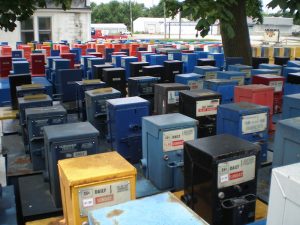This is a cautionary tale. According to NPR’s Marketplace, in the last twenty years 3200 newspapers in the U.S. have folded.
This has not been a good month for my home state of New Jersey. No less than four newspapers have announced they will no longer publish daily print editions, opting for digital news hybrids that are typically shorter and less thorough. The closure of the print edition of North Jersey’s Star Ledger—the state’s biggest paper—is especially a loss, but so is the demise of the print version of the Times of Trenton, a newspaper that serves the states’ capitol city. My county, one of the wealthiest in the country and one of the largest in the state, will lose print versions of the Hunterdon Democrat.
These closures are at the behest of New Jersey Advance Media, owned by the Newhouse family. These changes follow a pattern where group news owners gut local journalism, leaving many traditional functions like political reporting barely present. So far, the only remaining online versions of local news are hardly up to the task, unless you want to know that status of various high school wrestling teams. A check with Advance Media’s NJ.com yesterday led with a Dear Abby column.
If we thought the nation’s most densely populated state was in a news desert before, we have only begun to experience the sense of loss when there are no reporters left to describe what we need to know. Advance Media’s shrinking staff at their ghost papers try hard, but they can only do so much.
This is all happening in a state that is near the top in terms of literacy rates, family income, and educational attainment. It is also a surprisingly complex state, with large forests and farms, a diverse population, a long coastline, and dense urban sprawl. But even with a state-based cable news channel, it is harder to know what is going in even the more local of the 500 municipal districts in the rest of the Garden State.
This is a cautionary tale. According to NPR’s Marketplace, in the last twenty years 3200 newspapers in the U.S. have folded. Some 208 counties in the country have no local news. Feel fortunate if your local news media are surviving in the traditional form of more extensive news coverage that is possible in print.

I see this broad decline in print journalism most dramatically in younger Americans, who have not only lost the newspaper habit, but the news-seeking habit as well. There are too many other choices that offer more immediate forms of gratification. Add in the double-threat of disinformation efforts from sources ranging local political operatives to the Kremlin, and we are ill-prepared to enter a public and informed discussion of vital issues. If anything, this last election is a reminder of the price we pay for a public seemingly ill-informed about the policy consequences of their votes. I’m afraid the founders of the nation would be appalled at the rampant fantasy-making that passes for discussion in our own”information age.”
![]() To be sure, we are engaged with others in an endless spectrum of online communities. But in no sense should we consider most platforms as comparable vehicles for meaningful public “discussion.” If we need a comparison, the typical social media post more closely resembles a shout issued from a passing car than a considered account of an important event. Becoming an informed citizen means reading more than a few sentences or seeing a 90-second video news report. And that’s assuming you can find a news organization dedicated to need to know news as much as want to know news. In the words on the masthead of the Washington Post, The lights seem to be fading in ‘democracies that die in darkness.’
To be sure, we are engaged with others in an endless spectrum of online communities. But in no sense should we consider most platforms as comparable vehicles for meaningful public “discussion.” If we need a comparison, the typical social media post more closely resembles a shout issued from a passing car than a considered account of an important event. Becoming an informed citizen means reading more than a few sentences or seeing a 90-second video news report. And that’s assuming you can find a news organization dedicated to need to know news as much as want to know news. In the words on the masthead of the Washington Post, The lights seem to be fading in ‘democracies that die in darkness.’
At the same time, the consumption of reliable online news occupies less of our time. The resulting fragmentation of the nation into specific audiences means that it is less likely that Americans will pay attention to significant events, or even the same informational sources. If you ask friends what they are seeing online or on cable, the odds are good that “their” content is different than yours. Neil Postman had it mostly right in his classic 1985 book, subtitled “Public Discourse in the Age of Show Business.” We are indeed Amusing Ourselves to Death, but with more esoteric ‘narrowcasting’ that satisfies the personal over the collective national interest.


